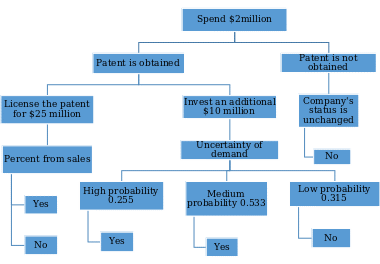BMAC, a research and development company, faces a dilemma that might impact its future development and growth. At the moment, it has an option to invest $2million to continue with a specific drug development research project. However, it can be a risky venture because of the lack of guarantees that the decision will be successful and BMCA will acquire stable revenues. For this reason, the fundamental objective of the company in the given decision problem is to ensure that the selected option will result in getting patent and sales to clients (Rothaermel, 2018). For this reason, it is vital to consider all options and employ the most profitable one.

The given influence diagram represents some possible consequences and factors linked to the accepted decision. If BMCA decides to invest, it might either license an additional $25 million and acquire revenue or demand an extra $10 million to organize direct sales of the product with the unpredictable uncertainty of demand. In such a case, the brand might experience additional losses and focus on promoting the good to increase its popularity. All these options are linked to the decision that should be made by the company.
Decision Tree

The given decision tree can also be used as a tool for analyzing possible results of BMAC’s steps and strategies for investment.
In such a way, both the influence diagram and a decision tree can be viewed as potent options to investigate a certain problem and find an appropriate solution for it. For the BMAC’s case, they help to visualize the current dilemma, consider all possible alternatives and options, and cogitate about the consequences of accepting a specific decision (Díez et al., 2017). Moreover, these methods cultivate a better vision of the problem as they structure it and outline all uncertainties and possible barriers to attaining final goals. It means that the application of these tools to different scenarios or problematic cases helps to analyze them and improve problem-solving and decision-making.
The academic literature also proves the importance of influence diagrams and decision trees for various spheres today. Their applicability is not limited by the business world of the work of a particular company (Qiao et al., 2017). For instance, analysis of physiological and environmental factors affecting heart rate variability can be performed using an influence diagram. In the journal article Influence diagram of physiological and environmental factors affecting heart rate variability: an extended literature overview, the authors use this approach to discuss all aspects linked to the problem, uncertainties, and how they might impact a person (Fatisson, Oswald and Lalonde, 2016). Using this approach, specialists acquire the chance to visualize the problem, discuss it, and offer unique solutions (Shaheen, Zafar and Ali Khan, 2020). Moreover, decision trees are used in healthcare to determine the probability of a particular intervention and outcomes linked to it.
Altogether, the BMAC’s case demonstrates the complexity of making a particular solution and selecting a development strategy. This demands consideration of all factors relevant at the moment and forecasting skills. Influence diagrams and decision trees can be viewed as potent tools simplifying this task as they contribute to the better analysis of a particular problem, its processing, and visualization. The existing body of literature also proves the high applicability of these methods and their important role in decision-making and problem-solution activities. Applying these approaches, it is possible to investigate various cases and select the option that fits the current demands and create the basis for the future rise.
Reference List
Díez, F. J. et al.(2017) ‘Markov influence diagrams: a graphical tool for cost-effectiveness analysis’, Medical Decision Making, 37(2), pp. 183–195.
Fatisson, J., Oswald, V. and Lalonde, F. (2016) ‘Influence diagram of physiological and environmental factors affecting heart rate variability: an extended literature overview’, Heart International, 11(1).
Rothaermel, F. (2018) Strategic management: concepts. 4th edn. New York, NY: McGraw-Hill Higher Education.
Shaheen, M., Zafar, T. and Ali Khan, S. (2020) ‘Decision tree classification: ranking journals using IGIDI’, Journal of Information Science, 46(3), pp. 325–339.
Qiao, Y. et al. (2017) ‘Decision tree for postflooding roadway operations’, Transportation Research Record, 2604(1), pp. 120–130.